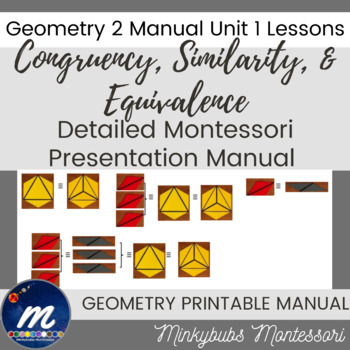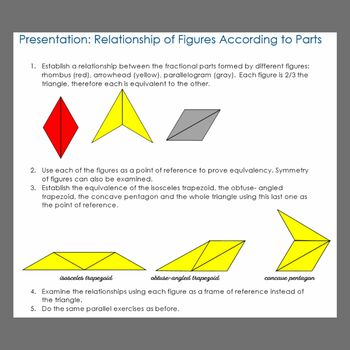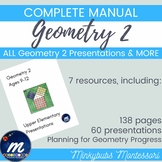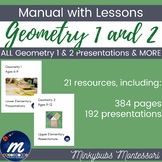Geometry 2 Congruency Similarity Equivalency Lessons Montessori Album Unit 1
- PDF
Also included in
- Lower Elementary Montessori Geometry 2 Comprehensive Teaching Manual and the Story of Geometry: 3+ years of Geometry CurriculumThe only complete and comprehensive Upper Elementary Montessori Geometry Manual you will ever need. This is for children aged 6 - 9 years. This manual was created by an AMSPrice $34.00Original Price $46.00Save $12.00
- ALL Lower and Upper Elementary Montessori Geometry 1 and 2 Comprehensive Teaching Manual and the Story of Geometry: 6+ years of Geometry CurriculumThe only complete and comprehensive Elementary Montessori Geometry Manual you will ever need. This is for children aged 6-12 years.This manual was createPrice $90.00Original Price $127.00Save $37.00
- ALL Lower and Upper Elementary Montessori Geometry 1 and 2 Comprehensive Teaching Manual and the Story of Geometry: 6+ years of Geometry CurriculumThe only complete and comprehensive Elementary Montessori Geometry Manual you will ever need. This is for children aged 6-12 years. Plus all of the GeomePrice $155.00Original Price $234.00Save $79.00
Description
Concept of Congruency, Similarity, and Equivalency Manual with Lesson Plans
Prove the concepts of congruency, similarity, and equivalency sensorially and numerically.
Save yourself HOURS of work.
This is Unit 1: The Concept of Congruency, Similarity, and Equivalency
This resource is relevant to ANY child, regardless of whether they have been in a Montessori environment or not. It is suitable for parents and/or teachers and perfect for homeschooling. 12 concept lessons/presentations featuring background information, detailed instructions, photographs, and illustrations.
These presentations are used to prove the concepts of congruency, similarity, and equivalency and prepare the child's mind for further work in area.
This resource includes:
- Constructive Triangles, Set 2A: The Triangular Box of Coloured Triangles Materials Analysis
- Constructive Triangles, Set 2B: The Large Hexagonal Box of Coloured Triangles Materials Analysis
- Constructive Triangles, Set 2C: The Small Hexagonal Box of Coloured Triangles Materials Analysis
- Presentation 1: Triangular Box (T1) – Equivalency
- Presentation 2: Triangular Box (T1) – Relationship of Figures According to Parts
- Presentation 1: Large Hexagonal Box (H1) – Forming New Figures
- Presentation 2: Large Hexagonal Box (H1) – Relationship of Figures According to Parts
- Presentation 3: Large Hexagonal Box (H1) – Relationship of Figures According to Lines
- Presentation 1: Relationship between the Hexagon and the Triangle/Quadrilaterals – According to Sides
- Presentation 2: Relationship between the Hexagon and the Triangle/Quadrilaterals – According to Lines
- Presentation 1: Small Hexagonal Box (H2) – First Level
- Presentation 2: Small Hexagonal Box (H2) – Relationship According to Parts
- Presentation 2: Small Hexagonal Box (H2) – Relationship According to Lines
- Presentation 2: Small Hexagonal Box (H2) – Second Level
- Presentation 2: Small Hexagonal Box (H2) – Relating the Figures from (H2) and (T1)
This bundle is useful for children from ages 10-12 years of age and up.
This resource is the 1st unit of the AMS Montessori Geometry Curriculum for 9-12 year olds.
Please note that these lesson plans are written and illustrated by hand.
Download the Classified Nomenclature Cards for Series 1 (Unit 5) FREE here:
Series One: Classified Nomenclature Cards
Please see my Story of Geometry here (FREE):
⭐Looking for Geometry for younger children?⭐
Please see my set of Geometry Cabinet presentations and Analyses here:
Please see my set of Constructive Triangle presentations and Analyses here:
Unit 3: Constructive Triangles
Please see the set of Geometric Solids presentations and Analyses here:
Unit 4: Geometric Solids
Please see the set of Geometric Basics presentations and Analyses here:
Unit 5: First Series: Basic Concepts of Solids to Point to Solids
Please see the Second Series: Study of the Line Manual section here:
Unit 6: Second Series: Study of the Line
⭐⭐⭐⭐⭐⭐Did you know? When you leave feedback on a purchase, you receive credits towards future purchases from TpT!⭐⭐⭐⭐⭐
*Please message me if you have any questions; I am happy to help.








